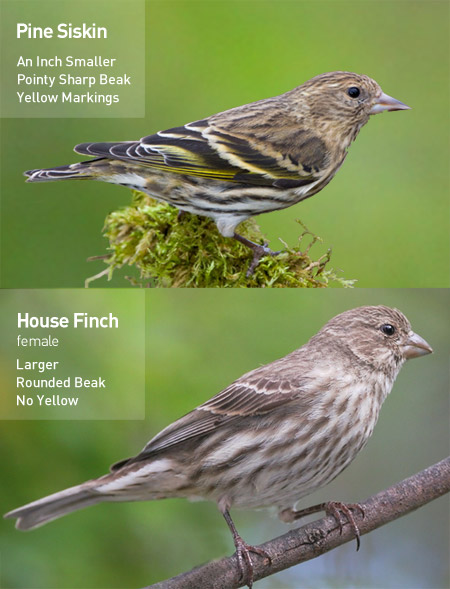Five years ago, when we first published this resource page about Pine Siskins and how to identify them, we were marveling over their rare visit to our area. Now, in 2020, it’s happening again. But this time, we’re witnessing what’s possibly the biggest Pine Sisken irruption in recorded history.
But, wait… There’s more.
It’s not just Pine Siskins! They’re being joined by Red-breasted Nuthatches, Purple Finches, Redpolls and Crossbills. And here’s another stunner: the Evening Grosbeaks irruption is the largest in over 20 years.
Why? They Follow the Food!
Conifers in their Canadian forest habitat had a low seed crop this year. They’re on the move South in search of food, so this is the best opportunity to see these birds, up close, in your own backyard. We were surprised and delighted by spotting two dozen Pine Siskins at our feeder station in the parking lot behind the shop.
Where are they usually? It depends. These Northern finches are tiny nomads who follow food availability which can vary widely from year-to-year, depending on how weather has affected pine tree seed production. Here’s an excellent explanation of climate-driven bird migration, with Pine Siskins as the focus.
Keep your eyes open and your feeders full!
Have you seen Pine Siskins flocking to your feeders? They are truly fun to watch—and to hear!
How to Identify Pine Siskins

The Pine Siskin is smaller, with distinctive yellow markings and a sharp, pointy beak.
Photo by Raymond Lee
Appearance
Pine Siskins are not as vividly hued as Goldfinches, being mostly streaky brown with more subtle yellow markings on the edges of tails and wings. Look for flashes of yellow as they flutter around your tree branch tips. If you don’t spot yellow, you might confuse them with female House Finches. [See image below.] However, Pine Siskins are up to an inch smaller with slimmer and uniquely shaped pointy bills, short forked tails and pointed wingtips.
Sound
Zhreeeee! Pine Siskins forage in small tight flocks and vocalize constantly to each other— during flight, while they’re foraging, while they’re doing just about everything except sleep! They have a very distinctive “wheezy” or nasal call, and punctuate their songs with a noise sometimes described as a harsh, ratchet-y “watch-winding” sound. And, we’re not kidding, it is non-stop!!! Listen to the Cornell Lab‘s Pine Siskin recordings.
Behavior
Want to see Pine Siskins in your backyard? Hint: It’s all about the food… (and water!)
Like American Goldfinches, Pine Siskins will feed upside down! Your best bet to lure these entertaining guests to your backyards, is to stock feeders with nyjer (thistle) or a nutritious nyjer blend that includes fine sunflower pieces, like our Finch Favorite. The Bottoms Up Feeder by Droll Yankees is perfect and will keep pesky house sparrows at bay.
If you haven’t cleared out your garden yet, you may also see them seeking weeds with seed heads, like dandelion. However, you are not likely to see a Pine Siskin hopping along the ground. Look for them clinging to the tips of conifer branches, picking through cones for tasty seeds.
Tempt them with a bird bath or fountain kept fresh and filled. With temperatures beginning to drop, make sure your bird bath water remains ice-free and accessible. We just can’t emphasize this enough: For wild birds, access to water is critical during every season. See Wild Birds, Winter and Water for tips and more.
Watch for Their Traveling Companions
In a year when we see Pine Siskins in our area, it’s not unusual that other Northern Finches such as, Common Red Polls and Purple Finches will also make an appearance. So keep your eyes open and your feeders full!

If you don’t spot the yellow markings right away, you might confuse the female House Finch with the Pine Siskin. Consult the Audubon Guide for North American Birds for the Pine Siskin and House Finch reference pages for more photos and info.
If you’re looking for a field guide, we stock a wide range of the best, most up-to-date field guides available and can help recommend the right field guide for all levels of birding and all ages of birders, too..
Pass along the good news! Let all the other Pine Siskin fans know if you’ve spotted them in your backyard. Please share your sightings with us at the store or on The Backyard Naturalist Facebook page. This doesn’t happen every winter, so enjoy the Pine Siskin show while you can.






